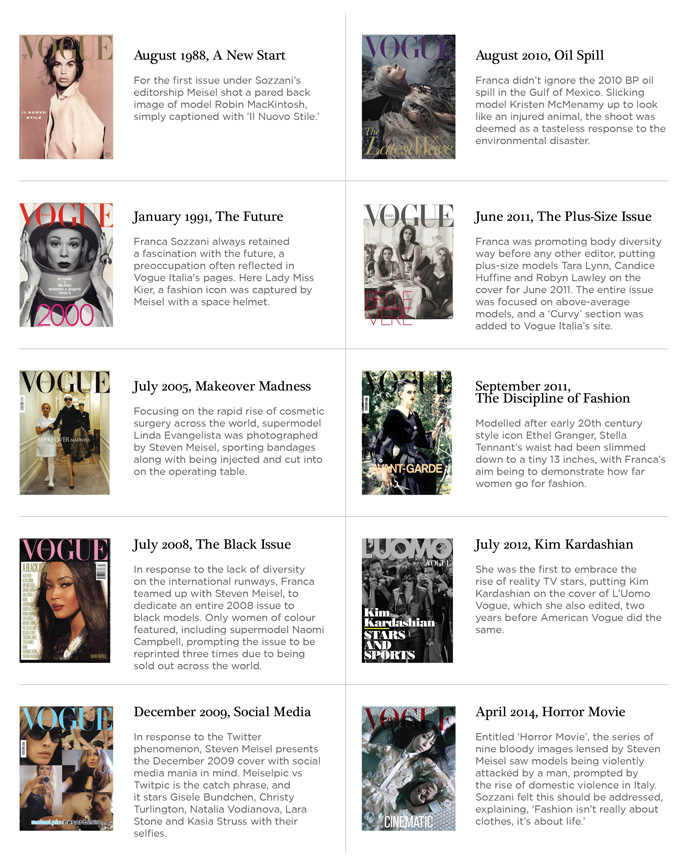

Franca Sozzani, the editor-in-chief of Italian Vogue, passed away on 22nd December 2016 after a year-long illness. While she might not have been a global household name like her US counterpart and friend Anna Wintour, she was undoubtedly a giant of Italian fashion.
Born in Mantua, her father, a classic Italian patriarch, was an industrial engineer who did not approve his daughter’s early ambitions to study physics. She studied literature and philosophy at university in Milan instead, and married soon after, although she knew, as she later admitted, that the marriage was doomed before she walked into the church. Franca would later confess that romantic relationships were the one weak link in her formidable arsenal of triumphs. The couple divorced three months later, and the free-spirited Franca went to India to find herself, followed by time in London, to nurture her creative spirit.
Franca was especially close to her only child, Francesco, whom she raised more or less alone. Like her, he studied philosophy, but spent recent years directing and producing a documentary about his mother. The result, Franca: Chaos and Creation, which had its premiere at the Venice Film Festival in September 2016, and will be released in early 2017. Francesco payed tribute to his mother, telling The New York Times, ‘My mother sacrificed herself for me and for her work.’
Franca’s illustrious career began with Vogue Bambini in 1976 with an assistant role, followed in 1980 with the editorship of Lei, aimed at young women, with Per Lui, its male counterpart, following in 1982. She transformed both these titles into displays for the most dynamic trends in international fashion and lifestyle image-making.
When Oliviero Toscani, her key photographer, moved on from her magazines, she began nurturing a dazzling talent roster of emerging photographers including Mario Testino, Paolo Roversi, Herb Ritts, Peter Lindbergh, Bruce Weber, and Steven Meisel, all of whom were attracted by the unprecedented editorial freedom that she gave them, and her passion for photography.
Allowing them to communicate through powerful imagery, she earned their unswerving loyalty and willingness to work with her magazines’ negligible budgets.
In 1988, Franca was appointed Editor in Chief of Italian Vogue, immediately shaking up the formulaic title with dynamic covers and content, creating a magazine that, in her words, would be, ‘extravagant, experimental, and innovative.’ Then by 1994, she was made Editor in Chief of Italian Condé Nast.
Franca Sozzani’s maverick spirit transformed Italian Vogue into a magazine that not only celebrated the power of the image, but also used fashion stories as a platform to discuss broader issues, and the obsessions of the fashionable world. Her fearless willingness to tackle provocative and controversial social and cultural issues through the medium of fashion shoots immediately began as she made a statement with her first issue, for August 1988, with the single cover line ‘Il Nuovo Stile,’ meaning, ‘The New Style’. Coupled with a sepia-washed black-and-white image by Meisel of model Robin MacKintosh, wearing a plain white Ferré blouse, this message signalled that she was not going to be playing by anyone else’s rules.
Not only a magazine editor, Franca also took an active role in social issues beyond the pages of her magazines. She was the creative director of Convivio, the AIDS initiative that Gianni Versace launched in 1992, and founded Child Priority with Jonathan Newhouse, to provide work opportunities for underprivileged children. Franca was also appointed global ambassador against hunger for the United Nations World Food Programme, with a focus on the empowerment and education of women and girls, and as their goodwill ambassador for Fashion 4 Development, she worked in areas including poverty and gender equality, through the medium of fashion-based initiatives. In this capacity, she travelled extensively through Africa, subsequently raising global awareness, and funds, to support the projects.
During Sozzani’s almost three decades at the helm of Italian Vogue, the magazine was transformed from one simply about clothes into one that championed its photographers, regularly broke boundaries, and never shied away from important issues. Here we look back at the most controversial covers under her editorship.
















